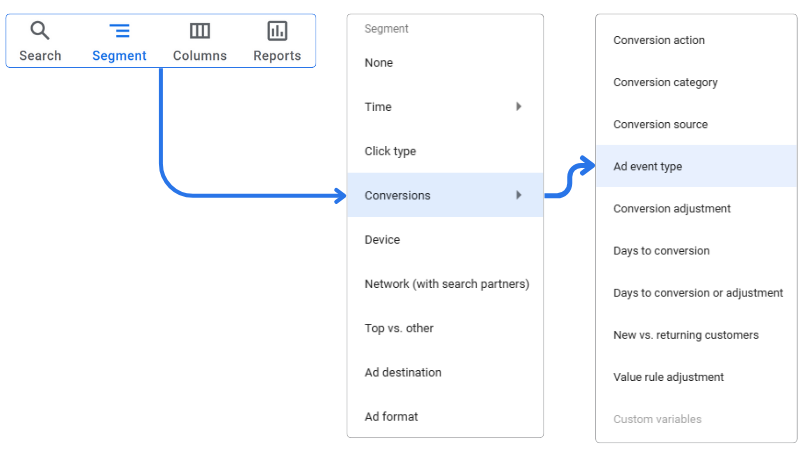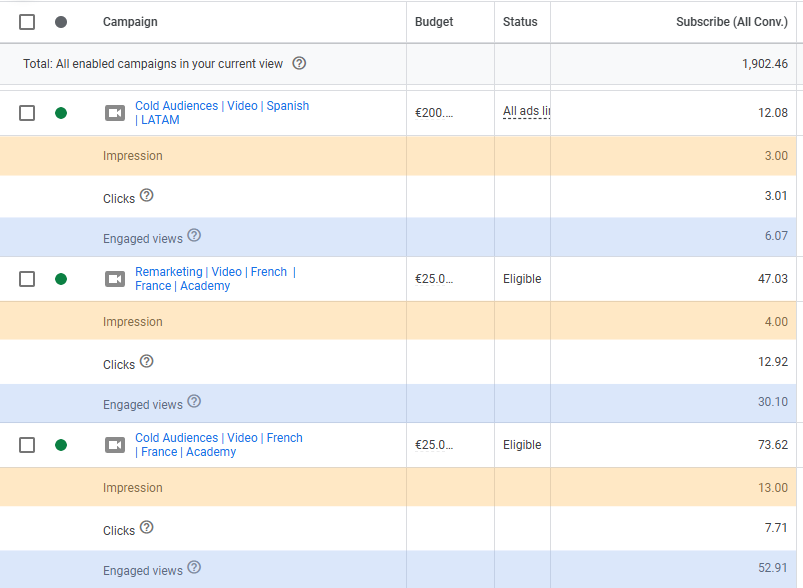
Don’t let Google Ads Inflate your Results
Table of contents
Did you know that the conversion metric you use to gauge how your ads are performing can be extremely inflated? This is especially true if you have PMAX, Video, or Display campaigns.
In this article, we'll explain how to break down the conversion metric so you can have the best possible insight into how your account truly performs. We will also go over how Google defines important metrics, what it means for you, and what you should do about it.
Need help with your Google Ads? Why not contact us?

When running video or display, you will encounter different types of conversions. I.E. Google has funny ways of counting sales inside of Google Ads. It’s important to understand how Google thinks about sales, because it’s guaranteed to be different than how you think of sales.
There are 3 kinds of conversions (sales) that Google counts: Click-Through Conversion, Engaged-View Conversion, and View-Through Conversion.
Click-Through Conversion: This is the simplest kind of conversion: someone sees your ad, clicks on it, and makes a purchase as a result. This is the kind of sale we all want more of, because it means our ads are doing exactly what we want them to.
Engaged View Conversions: This is the 2nd level of conversion. Someone watches a video ad for a bit longer after the “skip” button shows, (6+ seconds). If the same person that watched your video converts on your website at a later point, Google Ads will take full credit for it, even if the ad had very little impact on the individual.
View-Through Conversions: This is when someone scrolls past your image ad, skips your video right away, or doesn’t interact at all with your ad. If this person at any point in the future makes a purchase on your website, the mere fact that this ad was shown to them at some point in time, will allow Google to then take credit for this conversion by labelling it a “View-through” conversion.
These metrics can make your ads look like they're performing better than they really are. Here's why:
Forced Conversions: Google's algorithm is quite good at predicting when a sale will happen, so oftentimes they will show an ad to the person before they actually purchase. Then it will attribute to itself the sale. This is where the ad had no effect.
Overestimating Influence: Engaged View and View-Through Conversions can make it seem like your ads are driving more sales or leads than they actually are. Just because someone saw or watched part of an ad doesn't mean it was the reason they converted.
Minimal Engagement: For Engaged View Conversions, people only need to watch a few seconds of your video. That's a pretty low bar for counting a conversion, which might not reflect meaningful engagement.
Attribution Issues: View-Through Conversions give credit to ads that were only seen, not clicked. This can include people who were already planning to buy something from you, so it inflates how effective the ads seem.
It's also important to note that Google has been lowering the bar over time, making it easier to qualify as an Engaged View or View-Through Conversion. This gradual shift has blurred the lines between what counts as a view-through and what qualifies as an engaged view, which can affect how you interpret the effectiveness of your campaigns.
On the Campaigns dashboard, look for the “segment” button. Once found, navigate to “Ad Event Type”. This will allow you to see the breakdown of each conversion type, for your conversions.

Feeling like these metrics are giving you an inflated sense of success? Here are some steps to take:
Focus on Click-Through Conversions: Keep your eyes on conversions that come from people actually clicking on your ads. This gives you a clearer picture of real engagement. You can look at this by segmenting your conversions by ad event. Here’s an example where you can see how conversions are inflated with engaged views and impressions:

You can also look at this in a time series chart in Google Ads. You can clearly see how non-click conversions account for up to 72% of daily conversions in some cases!
Shorten the Attribution Window: You can reduce the time frame for counting these conversions. A shorter window helps make sure you're not crediting ads for conversions that happen way later. You can do this by going into your conversion actions settings and reducing the attribution window to the minimum for engaged views and view throughs.
Try Incrementality Testing: Run tests to see the real impact of your ads. Compare groups who see your ads to those who don't to figure out how much lift your ads are actually providing.
Cross-Check with GA4: Use Google Analytics 4 (GA4) to double-check the consistency of your conversion volume. If GA4 isn’t connected to Google Ads, it won’t track Engaged View Conversions, and View-Throughs Conversions aren’t even counted in GA4. This can give you a more accurate picture of your true conversion rate by focusing on direct user actions.
Check out how Google Ads attribution differs from GA4
Engaged View and View-Through Conversions can give you some extra insight into how your ads are working, but they can also inflate your results. By understanding these metrics and taking steps to manage them, you can get a more accurate view of your campaign's performance. This way, you'll know exactly how your ads are doing and can make smarter decisions to improve your results.
